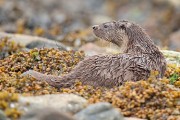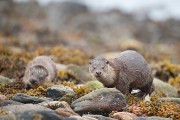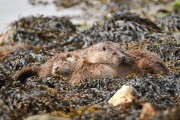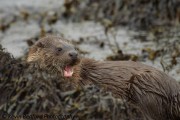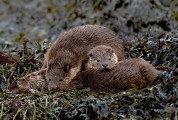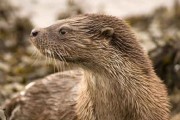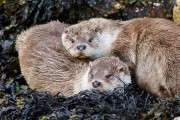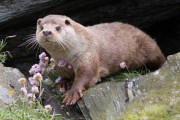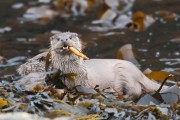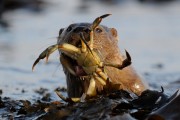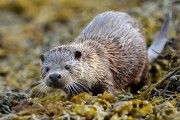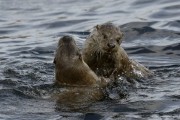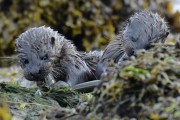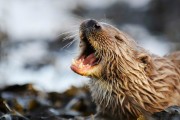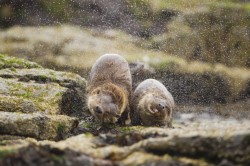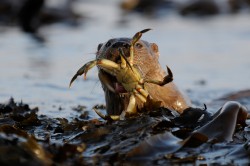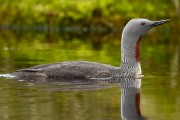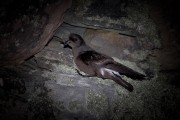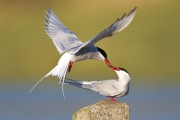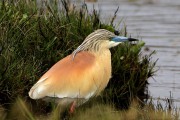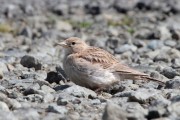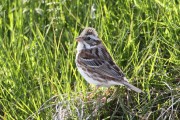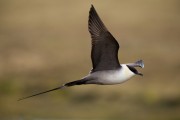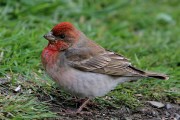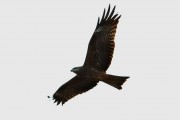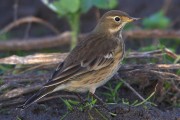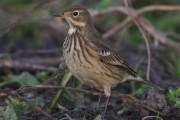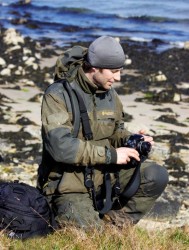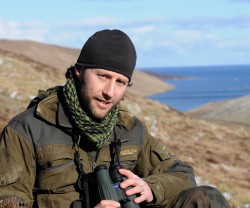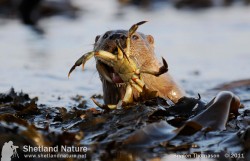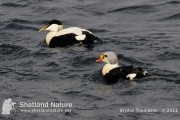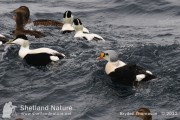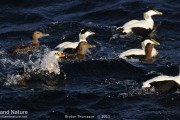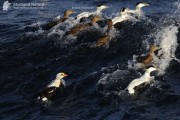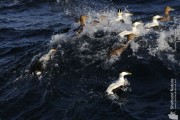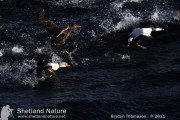Review of the Shetland Nature 2011 Season
Posted by Gary Bell on Wednesday 16th November 2011 | News
The review of the Shetland Nature 2011 season has appeared a little later than planned, but for good reason: the arrival of Brydon and Vaila’s second son, Corey James Thomason, who was born in early September. For this very joyous reason, many post-season tasks, such as reviews and news posts, were put on ‘paternity-leave’ hold. It is perhaps more appropriate in any case, as it means the review can now be a more complete overview of the year’s programme, and includes the last of the season’s holidays such as the Shetland Autumn Birding weeks which finished in October.
Spring/summer season review
Once again, we were very fortunate to enjoy an excellent season, with our programme of ‘Shetland Nature Experience’ (week-long) and ‘Wild Shetland Weekend’ (long weekend) holidays all selling out. In fact, such is the popularity and demand for the northern isles, we were able to offer and fill additional holidays to those initially advertised. There is no doubt that Shetland is definitely a ‘must visit’ location, and for many very good reasons! To quote Lonely Planet, who listed Shetland as one of its Top 10 regions in the world to visit in 2011: “this might just be the last untamed corner of the United Kingdom”.
This year saw a definite increase in visitors taking advantage of our highly successful Day Tours. More encouragingly, there was increased demand from people seeking tours in the ‘shoulder-seasons’ of early spring, autumn and even in winter than in previous years.
As far as sightings were concerned we certainly delivered; indeed, in many cases, as well as reasoned judgement we had luck on our side. Throughout the season, all of Shetland’s star speciality species were encountered and enjoyed, and for some lucky guests even all in one week. In fact, Otters, Killer Whales and Red-necked Phalaropes were encountered in one day!
Amongst the most sought after of all are, of course, Shetland’s enchanting and endearing Otters, which were enjoyed on all holidays on multiple occasions and all our day trips too. Otter watching is a real speciality of ours and one that we are justly renowned for (see also Otter watching day trips and Otter Photography holidays). Our groups really do experience first-hand the benefits of both our small group sizes and our knowledge of Otters and the sites they use. Dedicating time to track them on our week-long trips is also a huge attraction.
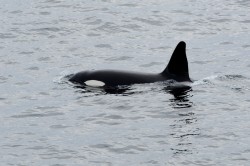
Killer Whales also provided several sightings throughout the season. Although several holidays and day tours enjoyed encounters, it was on the whole a ‘below par’ season for inshore Killer Whale sightings around Shetland, with fewer than normal of the known pods having been sighted. This is of course not unprecedented; no two summers are the same but thankfully Killer Whales always seem to come back! We were delighted to welcome back Dr Andy Foote of the North Atlantic Killer Whale ID project to lead on a couple of our marine-based day trips.
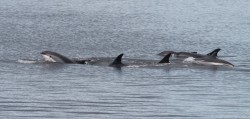
Other sea mammals seen included White-beaked, White-sided, Risso’s and Common Dolphins (the latter being quite a rarity in Shetland waters), whilst Minke Whale and Harbour Porpoise were the more frequently seen cetaceans, especially later in the summer. Also during the latter part of the summer were several Basking Sharks. In fact, it has probably been the best year for a couple of decades in Shetland for this species, which has only recently begun occurring with any regularity.
The summer breeding birds were typically more reliable (with the often frustrating exception of the increasingly more elusive Red-necked Phalarope); from Plovers, Petrels and Puffins to Gannets, Guillemots and Great Skuas and Red-throated Divers, Ravens and Razorbills.
Also from an ornithological outlook, several of our groups were fortunate to connect with some fine rarities and scarcities on our spring and early-summer holidays. Amongst the scarcer migrants were Long-tailed Skua, Red-backed Shrike, Golden Oriole, Marsh Warbler, Common Rosefinch, Corn Crake (including one lucky group which actually saw the bird singing in the open!), Quail, Crossbill, Wood Warbler and Wood Sandpiper to name but a few, whilst rarities such as Squacco Heron, Black Kite, Rustic Bunting and Subalpine Warbler added to the already impressive list of birds recorded on our holidays. In the field, you are always aware that you might find something unusual or rare. When it happens, it’s one of these experiences that is difficult to describe, but often involves adrenalin! This season went reasonably well, with the group leaders finding White-billed Diver, Black throated Diver, Ring-billed Gull, Pectoral Sandpiper and Short-toed Lark during our holidays or day tours. However, it’s not all about the rare species; unusual can relate to behaviour too. This year, amongst others, we have witnessed an Otter catching and running off with a domestic duck, another Otter running around amongst sheep, and a Shag attempting to consume a fish that was larger than itself!
Shetland’s wild flowers, plants and fungus provided breath-taking scenes as we toured around the islands. Stone dykes covered in symbiotic lichens alluded to a pristine environment. Carpets of Ragged Robin, Red Campion and Fox-and-Cubs gave way to patches of Yellow Iris and fields of Marsh Marigolds and were the aesthetic starters to Shetland’s rich flora. Orchids are always a popular delight and we were able to find Early Marsh, Early Purple, Frog, Fragrant, Heath Spotted and Northern Marsh, although different periods of the summer are better for certain species than others.
The Keen of Hamar National Nature Reserve on Unst is a weekly pilgrimage with us, and as well as providing scarce Orchids, the endemic Edmondston’s Chickweed and alpines such as Moonwort, Norwegian Sandwort and Northern Rockcress were found amongst many others.
Insect eaters! It often surprises people that we have insectivorous plants in Shetland and the commonest two, Round-leaved Sundew and Common Butterwort, were numerous in their preferred habitats.
Other fascinating plant encounters include the nationally scarce and declining Oysterplant, which spreads itself out on only a few shingle beaches in Shetland. We were able to see it at its best. Also, one of our guests wished to see a particular plant, and because of our small group size we were able to spend time seeking out the enigmatically named Grass-of-Parnassus at a site we know; this also led us to a very special Otter encounter. In Shetland, sometimes you just don’t know what’s around the corner!
North Isles Nature Cruise with Simon King
Having worked very closely with Simon over the past few years, we were delighted to have him feature on our North Isles Nature Cruise to Muckle Flugga this summer. This was our fifth summer running these adventurous and exciting marine wildlife cruises on the modern Yell Sound ferries, and our third to Muckle Flugga. With well over 100 passengers on board, this very popular voyage once again all but sold out. Having such a high profile personality as Simon on board was a real privilege for us, and one that we were very proud to offer as part of our summer season programme.
Autumn birding holidays
This year we ran two of our popular Autumn Birding holidays, both led by identification guru Martin Garner. A full review of the two weeks will follow soon. To whet the appetite, amongst the many species seen were Grey-cheeked Thrush, Swainson’s Thrush, Pallid Harrier, Lesser Grey Shrike, Black-headed Bunting, Surf Scoter, Olive-backed Pipit, Isabelline Shrike, Citrine Wagtail, American Golden Plover, Dotterel and Pectoral Sandpiper, as well as the more ‘usual’ scarcities such as Yellow-browed Warbler, Common Rosefinch, Barred Warbler, Red-backed Shrike and Bluethroat.
Also, look out for our round-up of Shetland birding in autumn 2011 (from July to November) – coming very soon…
Media and journalist trips
Throughout the season, we were delighted to be asked to lead several media journalists and press trips on behalf of both Visit Scotland and local tourism promoters Promote Shetland. Each summer, we are commissioned to work on such trips and are proud to do so, as it illustrates how highly regarded we are by local and national tourism promoters and are trusted to provide the Shetland experience they want visiting journalists to enjoy. This year, we were also proud to welcome visiting journalists from the Sunday Times, Time Out (London) and the Montreal Gazette, amongst others.
Media publications and websites
We were pleased with our continued association with leaders in the birding media Birdwatching and Birdwatch magazines. Our ‘reader holidays’ were sell-out successes, and we very much look forward to our continued association and working relationship with these publications. We are also delighted with our ongoing close ties with leading bird information providers Birdguides and Rare Bird Alert, and look forward to continuing to work closely with them over the forthcoming years.
We were pleased to further our association with Outdoor Photography magazine and are running a competition with them, offering a three-day Otter Photography workshop (with full board accommodation in association with Saxa Vord) worth over £1150! The competition/entry date ends in early December, see October’s issue for full details.
Scotland Outdoors is another publication we were very pleased to be approached by recently. Brydon will be the subject of their ‘Outdoor people – Day in the life of’ feature, which will be on the shelves in early November.
And finally, a big thank you…
To all of our guests in 2011, without whom our holidays and day tours would not happen. We are most grateful for all the positive feedback received (see our Testimonials).
To our accommodation providers: Neil and the staff Saxa Vord on Unst, and Keith, Beccy and the staff at Spiggie Hotel in south mainland and Steve Sharon and Gabriella at the Baltasound Hotel in Unst.
To Jonathan, Alan and Robbie at ‘Seabirds and Seals’ and Tom and Cynthia at ‘Mousa Boat Trips’ for getting us to Noss and Mousa respectively, often in somewhat trying circumstances.
2012 holidays
We are a small, locally-based company, employing guides who live and work in Shetland all year round, and as a result can offer an intimate and personalised experience of the islands that we are proud to represent. Our small group size of six people on all our holidays is unrivalled by any other company. The advantages of this benefit the wildlife and you. In 2011 this allowed our guests to enjoy Shetland in their own way, whether this was sketching, finding Grass-of-Parnassus, or putting in time and succeeding to find Red-necked Phalaropes.
Find out about our 2012 range of Shetland Nature holidays.
Permalink
Finding – a Team Effort
Posted by Martin Garner on Saturday 8th October 2011 | Birding in Shetland
Buff-bellied pipit, Quendale, Shetland, 08/10/11
I had finished two great weeks of guided birding SN groups and was set to enjoy a full (and more restful) day out with Roger Riddington. Roger and I had already enjoyed an excellent morning headlined by Citrine Wagtail, Isabelline Shrike and Pallid Harrier. The plan for us was to meet Paul Harvey and Brian Small around lunch time for a relaxed amble up the Quendale Burn.
Starting at Quendale Mill, some socialising with Andy Mackay and Mark Reeder meant I was lagging behind the other three and as I caught them up, laughter ensued as they pointed out I had no binoculars with me. Some birder! I ran back to the car, collected binoculars and caught up first with PVH. I had previously favoured the look of the Turnip/Kale field and suggested I would do it while the others continued working the iris-filled Burn. I asked his advice on how he thought the field could best be worked, and headed off. Nearing the top edge of the field, I noticed plenty of bird activity ahead: Twite, a Brambling, Redwings….I decided the fence line was the key zone and committed myself to work it carefully. Only taking a few more steps I noticed a movement amongst the cattle-chewed vegetables, put my binoculars onto it to see a bird that looked just like a Buff-bellied Pipit! It’s hard to say why it seemed rather obvious, the bird was in full view and not far away. I think partly I was fully genned up having made daily checks of numerous Meadow and regular Rock pipits for this very species. I had even made an excursion out onto the wild west side of Unst with Brydon T and our Shetland Nature group little more than a week earlier, specifically looking for Buff-bellied Pipit. Thus I had a high level of current familiarity with the common species.
Having made the initial shock assessment, I looked again and ticked off ‘big open face’, ‘rich apricot buff underparts’, ‘broad diffuse buffy wingbars’ and crucially the clinching feature for me; incredibly plain upperparts. I turned and none of the other three, now a field away, were looking in my direction. I didn’t dare shout, so I looked back at the bird, it was still there and it still looked just like a Buff-bellied Pipit. I turned around, praying now that someone would be looking my way, and thankfully Paul was. I waved frantically and all three were soon up and straight onto the bird. It took a moment for their shock to subside but all quickly concurring around a common thought- it really was one!
During the next 15 minutes it took a couple of shorts flights when we twice heard it give the rather distinctive call (again against the backdrop of multiple daily encounters with Meadow and Rock pipit) sort of Meadow Pipit x Grey wagtail. We watched and rehearsed the key features though bins and my shared ‘scope, occasionally losing it in the difficult vegetation, as Roger went to get more ‘scopes. Shortly after, news was put out, and within 25 mins of the first sighting, the initial vanguard of some 50-70 birders appeared. By now we had lost it in a denser weedy patch. Ten minutes later Brian picked it up, but it quickly took flight, landing over a third of a mile away in a grassy field on the edge of the Burn. Roger and Brian agreed to organise a flush line and eventually the bird was pinned down in the quarry area and all present got reasonable looks. Somewhat regrettably the pressure to release news and subsequent stampede meant I had little further chance to study, record plumage in greater detail and record the call. Modern birding! I gather it was last seen on 13th October and a number of excellent photos were taken. I suspect the Quendale regulars have much better set of notes on the bird!
Martin Garner
Permalink
Stealth Gear Smock – Review
Posted by Brydon Thomason on Sunday 29th May 2011 | Reviews
My introduction to Stealth Gear was with the Extreme Jacket Vest (and trousers). The jacket was like no other I had worn in terms of functionality, build quality and design. I had only been wearing the jacket for a matter of months when the Smock was launched.
Needless to say I couldn’t help myself and was enthusiastically intrigued to try it out, especially as the Smock was much more the style of jacket I typically prefer. I’m not entirely sure why this is maybe just the general fit that the style of a smock offers. In the past I have owned several ‘smocks’ of different designs, brands and materials.
When I unpacked it and before I had even tried it on I knew it would be my new favourite SG garment. The fact that it was noticeably lighter weight was the first thing I noticed and liked. One large pocket on the front replaced the many different pockets offered in the other jackets whilst there was splendid ‘hand warmer’ sized and lined pockets at either side. In short (and from a personal perspective) it was a much simpler and snugger fitting and slightly lighter weight option to the other jackets in the SG range.
The ‘kangaroo’s pouch’ style front pocket is certainly roomy to say the least and can easily manage mid-range sized lens and DSLR body. I personally however find it best for carrying my binoculars. I have lost count of the number of times I have laid off my bins whilst my adrenalin levels were peaking during a lengthy stalk (often crawling) especially whilst photographing Otters, only afterwards having to retrace my path to pick up my ‘bins’.
The only other two pockets are two small zippered breast pockets, either side of the neck zipper, which opens as far as the chest and I find is far enough. These two pockets are perfect size for all I often need/want to carry; my mobile (always on silent!!), spare battery, lens cloth and extra memory cards- inside the SG card wallet of course which is clipped into the small D rings and concealed inside the zipped pocket.
The Smock also comes complete with most other extras the other jackets have such as hood, mozzy/midge face net (which I use more for camouflaging my face), storm cuffs, removable elbow pads and has the same functional arm pit vents and side openings which I have open most of the time for crouching, crawling and extra venting.
I mention its lighter weight; this is because it lacks the multiple layers of material which the multiple extra pockets have on the other jackets. Most of the time I wear it (now bear in mind we are roughly 60 degrees north up here in Shetland!) either with just a T shirt on or just a long sleeve sweater but in winter it works brilliantly with the SG fleece. Needless to say, as with all the ‘gear’ the benefits of the forest green tones and the ‘rustle proof’ material make a world of difference when working with species as shy and secretive as wild Otters (both for me personally and indeed my clients when wearing the gear we supply them with on our workshops).

All in all it a fantastically functional, comfortable and brilliantly designed jacket – in my opinion the best one (or should I say personal favourite) in the Stealth Gear range.
Brydon Thomason
Permalink
Stealth Gear Double Bean Bag – Review
Posted by Brydon Thomason on Sunday 29th May 2011 | Reviews
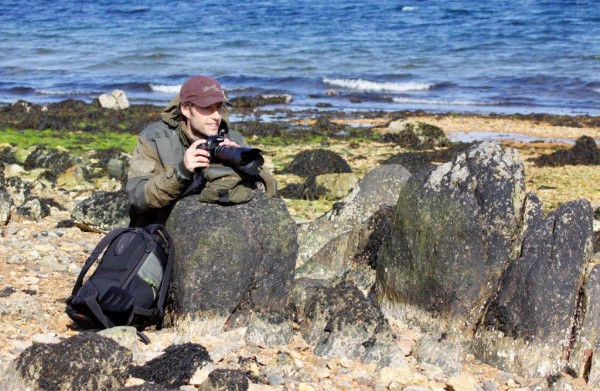
Out of all the kit you feel you should have as a wildlife photographer, a bean bag surely has to be a ‘must have’. Personally speaking I very probably use a bean bag far more than a tripod, whether it be balancing over a barnacle covered boulder in the ebb photographing Otters or out the car window, with camera and also telescope.
As a photographer Otters are undoubtedly my favourite subject and signature species. Perhaps surprisingly to some there are actually few occasions when a tripod may be practically used when stalking Otters (there are however exceptions to this of course). It is imperative that your silhouette blends in and merges into whatever your surroundings may be, whether it be boulders on a shore line or the contours of a grassy bank – your silhouette must not be seen.
With a bean bag it becomes much easier to lay flat or crouch tight against a boulder than if you have a tripod or monopod.
I was thrilled when I became aware that Stealth Gear were launching their own bean bag a few months ago. It came as no surprise what so ever when arriving in the post I saw that its design, engineering and manufacture was (as par for the course with all Stealth Gear products I have been supplied with), nothing but quality.
Previously I have used bean bags but it’s surprising just how many little gripes you can make about a bag of beans! But SG has come up with the good’s and designed a bean bag and (like all their products) that is just for photographers.
The bean bag itself is effectively ‘saddle’ shaped so it hangs/spreads itself very well either on solid ground or a car window. There is good sized zipper on one side which makes it easy to fill and empty when travelling whilst on the other there is a cheeky wee zipper for an accessory pouch.
One of my favourite features is the adjustable strap for carrying which even has a free moving cushioned section for comfort when carrying over the shoulder and for long hikes this is certainly
appreciated, especially as I often end up carrying two, one for myself and one for my Otter photography clients! It also has two different options for the strap to connect.

The general size I found to be just right both for carrying when full and also for what could be used on it; easily large enough for larger lenses such as 300 2.8, 500 and so on. The build quality is superb also and the material is waterproof – all in all it has brought the bean bag forward to a brand new level!
Brydon Thomason
Permalink
A Sperm Whale off Shetland
Posted by Brydon Thomason on Thursday 14th April 2011 | Sea Mammals in Shetland
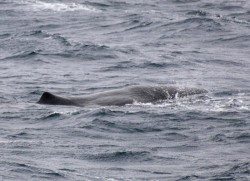
Although behaviourally there is similarity between Sperm and Humpback raising their tail flukes, in appearance they are quite different especially as Sperm lack the prominent white undersides. Their massive bulbous head can measure up to 30% of their overall body length.
On the 7th of April I received a text from David John Anderson, a friend of mine working on board the Skerries ferry, MV Filla. His text described very briefly a large whale which he believed to be a Humpback which they had seen and photographed from the ferry mid-way between the Mull of Eswick and the North mouth of Lerwick Harbour. Needless to say on reading the message I was quick to call him back. His description firstly of the whale lying motionless at the surface quickly urged me to mention Sperm Whale’s characteristic ‘logging’ on the surface. Their views however were leading them much more along the trail of a Humpback and they seemed fairly convinced that that was what it was.
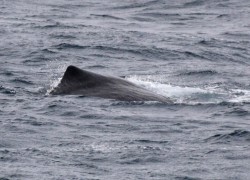
Incredibly Sperm whales have been known to dive to depths of 1000m or more and stay down for over an hour! They have the largest brain of any animal.
Later that evening however DJA downloaded his images and with a brief search of the internet compared them to Sperm and Humpback and tentatively re-identified the whale from his own images. Opening up the images he sent I was green with envy as he was indeed spot on and I have yet to see Sperm Whale in Shetland! As far as records of the species go here they are very much a rare sight inshore. The most recent report inshore off Shetland was back in 2007 when a pod of up to 20 whales were believed to be Sperm whales and before that there were at least 12 off of Noss in 2005. ‘None stranding’ reports or sightings such as these usually refer to pods on their migration. Further offshore they can be seen much more regularly. This sighting most probably involved a male on his Northward migration. The whale was estimated by the ferry crew to be in the region of 40-50 foot in length!
A big thanks and well done to DJA for the haste in getting the news to me and for the use of his images.
Permalink
Killer Whales in Shetland – Sightings, reports and research
Posted by Brydon Thomason on Wednesday 13th April 2011 | Sea Mammals in Shetland
With several sightings of Killer Whales already this spring (leading to some confirmed identification matches) it is indeed very appropriate to bring the work of the North Atlantic Killer Whale ID project to people’s attention again. The continued support both locally within Shetland and indeed from visitors has been key to the success of the project to date. This summer we encourage and invite anyone fortunate enough to see or photograph Killer Whales in Shetland to please contact us to report the sighting. Although co-founder of the NAKID project Dr Andy Foote will be returning to Shetland this summer, he will not actually arrive until the 3rd of July when he will be joining us on our North Isles Nature Cruise with Simon King. Once again we are delighted to have Andy on board as sea mammal specialist and he is looking forward to sharing information, aims and indeed the progress of the Killer Whale ID project to date.
“In the absence of any of the research team for the first part of the 2011 spring/summer we are asking for reports and information on Killer Whale sightings to please be called or texted in to Brydon on 07786982773. Brydon has played an integral role in the project from the start and has been helping us both when we are there or away, so it seems like a natural transition and the best way for us to keep information and interest going within the isles. We also hope to make the ID catalogue available to the public as a free download at some point this summer.” Dr Andy Foote, NAKID
Dr Volker Deeke (a research fellow at the Sea Mammal Research Unit studying the behaviour of killer whales in Scottish waters) also hopes to be rejoining the Shetland Nature team this summer.
For an update of 2010 Killer Whale sightings visit www.shetlandnature.net/2010/12/02/killer-whale-sightings-in-shetland-2010/
And for more information on the NAKID visit www.northatlantickillerwhales.com
If you would like to find out about where and when in Shetland Killer Whales are seen this is also a good opportunity for wildlife enthusiasts throughout the Isles and indeed visitors to Shetland to consider following Shetland Nature on Twitter and Facebook. We have been using to filter news and reports of Killer Whale sightings as and when they happen, leading to more and more people enjoying encounters. Especially given our working relationship with the research team and acting as their point of contact for sightings and reports in Shetland this offers the most informed and up to date insight into Killer Whales around Shetland.
You can can follow our Twitter stream at twitter.com/shetlandnature
If you are a Facebook user you can join our page at www.facebook.com/shetlandnature
It’s not only Killer Whale sightings that you will be able to follow in this way but also all other wild and wonderful sightings, such as other exciting sea mammals and rare birds, which come via the local birding grapevine or straight from the scene as it happens!
Permalink
King Eider update
Posted by Brydon Thomason on Wednesday 6th April 2011 | Birding in Shetland
Only a matter of weeks after discovering the 1st winter drake on Bluemull Sound, this resplendent drake arrives off Uyeasound, Unst. As pleased as I was with the young King back in February, this magnificent looking chap really did raise the pulse. You can tell of course from my last King Eider posting I do indeed have something of an Eider afliction/addiction but with very, very good reason. They are all stunning seaducks and always a joy to watch, photograph or indeed in this case scan through large flocks in search of the rarer forms.
Any how, they are way too handsome for my words to do anywhere near justice, here are some images of the King from over the past few days.
Permalink


